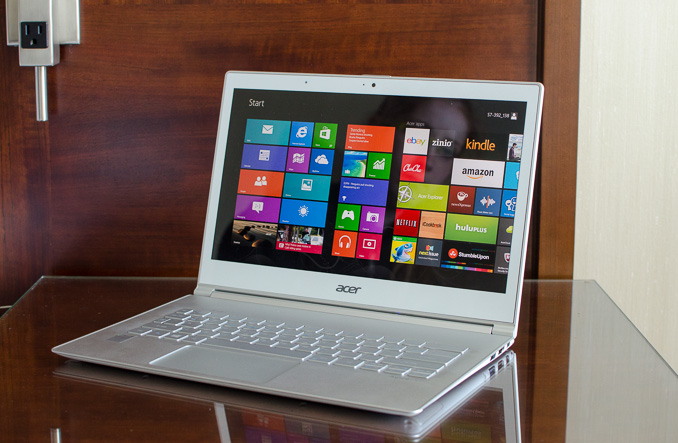The Haswell Ultrabook Review: Core i7-4500U Tested
by Anand Lal Shimpi on June 9, 2013 9:00 AM ESTFinal Words
On the desktop, Haswell offers a reasonable increase in IPC, and a decrease in idle power consumption. The combination of the two feel very evolutionary over Ivy Bridge however. In high-end notebooks, Iris Pro dramatically improves the processor graphics story by finally delivering discrete GPU class gaming performance. In Ultrabooks, Haswell’s offer is dominated by significant improvements in battery life.
Intel refers to Haswell ULT’s performance in Ultrabooks as being the single largest improvement in battery life of Intel history. As far as I can tell, that’s true. Under heavy load I wouldn’t expect any substantial increase in battery life, however most notebook usage models boast significant periods of idle time. Staring at your screen, browsing the web, or even multitasking all offer opportunities for idle power optimizations to kick in. That’s where Haswell ULT excels. Using Acer’s Aspire S7 as a comparison platform and normalizing for battery capacity differences I measured anywhere from a 15% to a 60% increase in battery life thanks to the move to Haswell.
Peak CPU performance doesn’t really change with Haswell ULT. Performance on battery on the other hand does improve by a bit over 10%. On the GPU side you should expect to see around a 15% increase in performance compared to last generation’s HD 4000 GPU. Neither improvement is significant enough to dramatically change the performance class of Ultrabooks, but the situation at least improves.
With the last generation of Ultrabooks, the tradeoff between portability and battery life was more evident than ever. The Ultrabook targeted Haswell U-SKUs aim to change that. Based on what I’ve seen here, they will.











87 Comments
View All Comments
StealthGhost - Sunday, June 9, 2013 - link
Is PCMark 8 Home less demanding than 1080p video? If not, it doesn't seem like the Asus can call itself an Ultrabook.Still, impressive gains in battery life. I hope this will carry over, to some extent at least, into the CPUs that will be in laptops like the MacBook Pros. Guess we will have to see when that review comes out =)
StealthGhost - Sunday, June 9, 2013 - link
*AcerDeath666Angel - Sunday, June 9, 2013 - link
As far as I know the Ultrabook specs don't define a minimum luminance for the display. So Anand's test isn't relevant for the Ultrabook spec.axien86 - Sunday, June 9, 2013 - link
Laptopmag just reviewed the Sony Vaio based on the i7-4500u and they also noted that performance wise the Haswell offered marginal improvement over Ivy Bridge laptops, while battery life was indicated as improved.One important characteristic that most laptop users want to know is regards to heat and fan noise. Laptopmag found that the Haswell i7-4500u based Sony Vaio found that the back of the laptop "reached a more troubling 110 degrees." They also found fan noise was definitely noticeable in a quiet room just running Word and a Youtube video.
http://www.laptopmag.com/reviews/laptops/sony-vaio...
The question is, why hasn't Anandtech run extensive temperature and noise characteristic analysis on Intel Haswell processors and your current laptop?
Kristian Vättö - Sunday, June 9, 2013 - link
Likely because of lack of time. As Anand said in the article, he got the unit while in Computex, so basically he did the review between meetings. I'm pretty sure he didn't have the equipment with him to do temperature or noise tests properly but I'm sure this is something that will be tested in later reviews.Also, keep in mind that heat and fan noise are system-dependent. If the Vaio has poor cooling, then it will be hot and loud but that's not Haswell's fault (I'm not saying this is the case but we obviously need more reviews before any conclusions can be drawn).
mavere - Sunday, June 9, 2013 - link
"The question is, why hasn't Anandtech run extensive temperature and noise characteristic analysis on Intel Haswell processors and your current laptop?"The WHr of battery that a laptop consumes is the exact same thing as its heat output.
Anand is trying to test the Haswell platform, not the design deficiencies of any specific manufacturer. Sony's problems are its own.
n13L5 - Sunday, June 9, 2013 - link
Cause they had to run their test in Taiwan with a borrowed machine?I was rather disturbed by the temperature of Sony's Vaio Pro, as well as the instability of the carbon case, which must be paper thin... And their keyboard backlight has the worst bleed I've ever seen, they should have a look at Lenovo and Samsung keyboards...
Well, I'll be waiting for more tests and the ULT Haswell with the Iris 5100 GPU. Maybe that'll rack up a high enough temperature to fry a steak.
akbisw - Monday, June 10, 2013 - link
Sony has terrible cooling system in their laptops in general. The worst I have seen done by any manufacturer. Even my my old acer before their "reiteration" had better cooling design than current VAIO systems.Dnann - Friday, June 14, 2013 - link
He probably didn't have the time considering the circumstances...DanNeely - Sunday, June 9, 2013 - link
The fact that companies historically known for horrible battery life are getting good results out of Haswell with Intel's help is promising; but starting from such a horribly low baseline makes getting gains much easier. I'm much more interested in seeing what companies who've historically offered good battery run times will be able to do with Haswell.